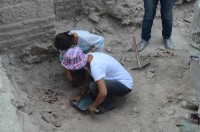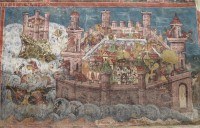 Archaeologists have discovered a unique trove of ancient medicine bottles in the ancient Greek town of Bathonea, 10 miles west of Istanbul. Usually made of ceramic or glass, although there are a few high-end examples made of alabaster and silver, the small bottles known as unguentaria were used in antiquity to hold everything from perfume and cosmetics to olive oil and powdered incense. They are often found in Greek burials as grave goods, but only a few in each grave. Larger numbers of unguentaria have been unearthed in ancient household rubbish dumps, discarded over a period of time after being broken.
Archaeologists have discovered a unique trove of ancient medicine bottles in the ancient Greek town of Bathonea, 10 miles west of Istanbul. Usually made of ceramic or glass, although there are a few high-end examples made of alabaster and silver, the small bottles known as unguentaria were used in antiquity to hold everything from perfume and cosmetics to olive oil and powdered incense. They are often found in Greek burials as grave goods, but only a few in each grave. Larger numbers of unguentaria have been unearthed in ancient household rubbish dumps, discarded over a period of time after being broken.
The ones found at Bathonea, on the other hand, were all made at the same time out of clay in the shape of miniature amphorae, and 700 unguentaria in one site is an unprecedented find. Many of them were also in fragments — archaeologists pieced hundreds of them back together in the laboratory — but they weren’t discarded or funerary/religious offerings. This was an industrial facility for the manufacture of unguentaria and likely for their contents.
Samples of material found inside the vessels were sent for analysis to the Scientific and Technological Research Council (TÜBİTAK) in Gebze district. Tests found the residues contained Methanone and Phenanthrene, plant-derived substances used in herbal medicine as anti-depressants and heart medications, among other uses.
“Some of them are still being repaired, but meanwhile we have also found pestles of various sizes, mortars, and a stove, indicating that there was a pharmaceutical production center here” [associate professor from Kocaeli University Dr. Şengül] Aydıngün said, and added that there are specific plants on the site, which make up the essence of many medicines.
They also found bone tools, spatulas and medical instruments, so this appears to have been a full-service drug and medical supply store.
 This roof of this facility collapsed in a fire, keeping its production line in place even if heavily damaged. Practically all of the structures so far excavated at Bathonea have the same fire layer. Samples from it were analyzed by the Wroclaw Archeology and Ethnography Institute in Poland which found that the carbon samples date to between 620 and 640. That date range is meaningful because the nomadic Avars joined forces with the Sassanid Persians and assorted Slavs to besiege Constantinople in 626. After two months of attacks from land and sea, the Avars and Persians retreated before the victorious Byzantines, but they did a lot of damage while they were there. Archaeologists think the fire that felled the Bathonea pharmacy may be evidence of the Avar attack. No other archaeological evidence of this clash has been found before.
This roof of this facility collapsed in a fire, keeping its production line in place even if heavily damaged. Practically all of the structures so far excavated at Bathonea have the same fire layer. Samples from it were analyzed by the Wroclaw Archeology and Ethnography Institute in Poland which found that the carbon samples date to between 620 and 640. That date range is meaningful because the nomadic Avars joined forces with the Sassanid Persians and assorted Slavs to besiege Constantinople in 626. After two months of attacks from land and sea, the Avars and Persians retreated before the victorious Byzantines, but they did a lot of damage while they were there. Archaeologists think the fire that felled the Bathonea pharmacy may be evidence of the Avar attack. No other archaeological evidence of this clash has been found before.
The site of Bathonea was first confirmed in 2009, after documentary research and geophysical surveys pointed to its location being in the basin of what is now Lake Küçükçekmece, a lake created when a sandbar cut it off the Sea of Marmara. Bathonea was a bustling port city, and in five years of excavations archaeologists have unearthed the remains of a large port, docks, a lighthouse, long, broad avenues to the sea, a palace complex, planned city squares and streets, two major waterways and a cistern built with bricks bearing the mark of the Emperor Constantine. Other artifacts discovered indicate the site has been occupied long before the construction of the Hellenistic city in the 4th century B.C., objects going back as far as the Neolithic (8,000 B.C.) have been found at Bathonea. The city was abandoned in the 11th century after a massive earthquake and never rebuilt.
Bathonea’s extensive archaeological record is or particular significance because it’s on the outskirts of Istanbul and can therefore fill the gaps in the capital city’s own chronology. For example, Istanbul’s Neolithic era is relatively well documented archaeologically, but there is nothing from the Hittite era (ca. 2,000 B.C.). The discovery of Hittite ceramics in Bathonea, therefore, was confirmation of their active presence in the area. The burn layer in the pharmaceutical facility and its neighboring structures has now added to that chronology by providing the first archaeological evidence of the major upheaval in the 7th century.
As the English word for the Latin unguentum is in fact unguent, I reckon unguentaria can still be used for all kinds of containers with ointments or fats.
The Greek expression for unguentarium, by the way, seems to be οἰνανθάριον (a compound ointment, cf. οἰνάνθινος for ‘made of the wild-vine flower’).
Fun-fact: In the mid-1950s, my own -more or less Avar- late grandfather was sent to the outskirts of Istanbul, as some kind of technical director, in order to set up a -still existing- pharmaceutical production center.
Nifty story. And an interesting parallel followup from Triclinius. I love it when that happens.